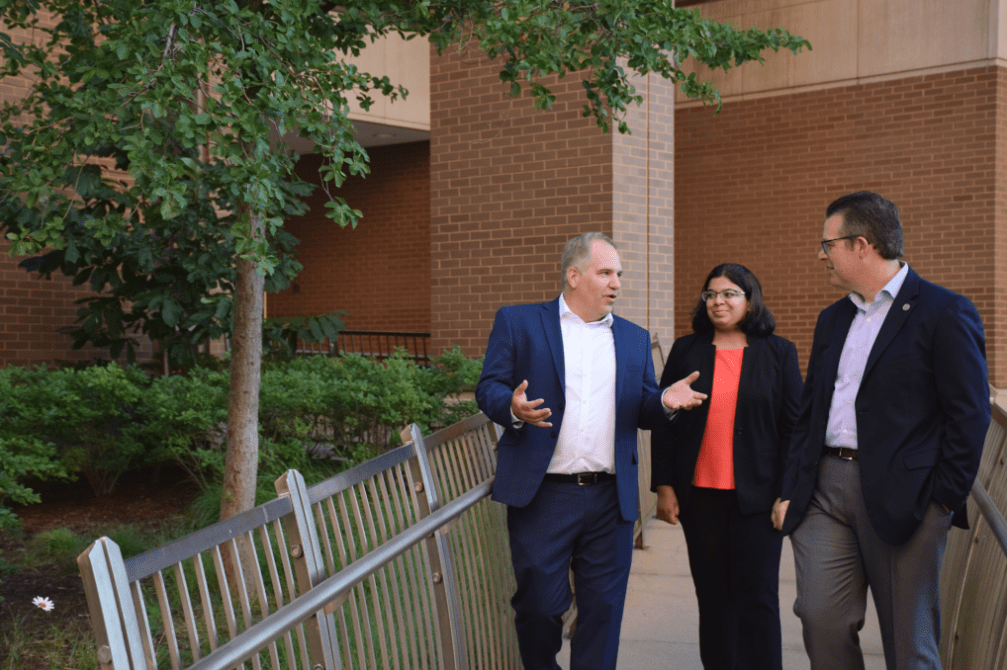How can you harness the power of data to improve patient care? The Institute for Informatics is launching the Center for Applied Clinical Informatics (CACI) to do just that.
“We want to translate what we’re doing in our laboratories in the Institute for Informatics into solutions that we can apply in our clinics, in our hospitals, and wherever we deliver care,” says Philip Payne, PhD, chief data scientist and director of the Institute for Informatics. “The goal is to improve quality, safety, and outcomes by using the data we have more intelligently. It’s about moving discovery in informatics out of the laboratory and into practice.”
The new center is spearheaded by Adam Wilcox, PhD, who, before joining CACI, was the chief analytics officer at UW Medicine and professor of biomedical informatics at the University of Washington. “There’s a lot of power in clinical data. That’s why it’s a passion for me. It helps those at the front lines do their jobs more easily, more efficiently, and more effectively,” he says. “Healthcare is constantly learning, and we need to learn from it.”
Finding Better Treatment Options for Patients Sooner
Culling data from electronic health records is one way to speed up successful treatments. “We want to learn faster and more efficiently from real data,” Wilcox says.
The current method for clinical research — randomized controlled trials — is effective, but the process takes a long time. Many patients have to forego treatment until researchers can finish their trials and draw conclusions. That’s called evidence-based practice, and it’s solid science. But if you could get similar results more quickly, you could help more people and help them sooner.
“We need to get to ‘practice-based evidence’ as well as ‘evidence-based practice,’” Wilcox says. “That’s where we learn from data in our health system, understand the nuances, put together different types of information, and apply those lessons.”
For example, suppose you see your doctor for a health concern. Data pulled from electronic health records shows that 30 people were recently treated for a similar condition and 15 of them got treatment A while 15 of them got treatment B. The data also shows that 90 percent of the people who got treatment A got better, while only 50 percent of those who got treatment B improved. That’s valuable information you and your doctor can use when making treatment decisions.
“That’s an example of practice-based evidence, where you can say, ‘It looks like this is the way we want to move forward,” Wilcox says. “Ideally, the electronic health record should have that capability, but we’re not there yet.”
Researchers within the center are identifying ways to get us closer to that goal. Joanna Abraham, PhD, associate professor of anesthesiology at the School of Medicine, is studying how information can support decision making in perioperative care. “When we understand the information needs of clinicians, we can use informatics to meet those needs directly and improve care,” she says.
Another piece of the electronic health records puzzle is clinical workflows. Thomas Kannampallil, PhD, associate professor of anesthesiology and associate chief research information officer at the School of Medicine, studies clinical workflows and decision support interventions. “Just having electronic health records doesn’t solve the information challenges in clinical workflows,” he says. “In some ways, EHRs have actually interrupted workflows. But by applying informatics principles, we can get the right information at the right time to clinicians.”
And finally, there’s the issue of transferring lessons learned in applying clinical informatics to design, develop, and implement informatics tools across institutions, which is what Po-Yin Yen, PhD, RN, associate professor of medicine at the School of Medicine, is working on. “There’s so much that we can learn from each other in the field,” she says. “Having a center helps us collaborate and share lessons with other institutions.”
Building the Systems Needed to Share Data Across Healthcare Institutions
Systems like those that can mine data for patterns are part of the solutions that can improve patient care, but you also need the ability to make those systems work. “The goal is to figure out sustainable and transferable methods,” Wilcox says. “At the Center for Applied Clinical Informatics, we have the right combination of people who can do this well.”
One crucial component is sharing data among institutions. The COVID-19 pandemic drove home the value of learning from shared information. “COVID demonstrated the importance of data and showed us that whatever we thought we had in terms of our use of informatics, it wasn’t as good as we needed it to be,” Wilcox says.
Sharing deidentified data among diverse healthcare institutions, both in St. Louis and as part of multi-site collaborations, also allows researchers to address disparities by analyzing a more representative slice of the population than any one site can do alone. “We need to identify the interventions that work best — that don’t exacerbate the digital divide, but help those who are suffering from disparities to advance,” Wilcox says.
By analyzing data, researchers can also track progressions. For example, dashboards can now track COVID-19 populations in hospitals. “If we can do that in a national emergency, we can do it for other diseases,” Wilcox says. “And places that have used data really well haven’t just done it to be more efficient and effective. They’ve done it to be transformative. I believe that Washington University in St. Louis can be transformative in terms of driving excellence with data. There’s a clear understanding of the need for it, and there’s a critical mass of scientists in applied clinical informatics.”
Learn more about the Center for Applied Clinical Informatics.
